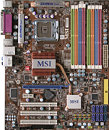Monday, March 9th 2009

MSI Unveils DDR2+DDR3 Combo Motherboards
During CeBIT, MSI showcased two AMD 790GX motherboards that combine support for both DDR2 and DDR3 on the same board. Although both the MSI 790GX-8D and the MSI P45-8D are designed for different platforms, the enormous RAM capacity support - both offer four DDR2 slots and four DDR3 memory slots - makes them really unique. The AM3 board 790GX-8D featuring the 790GX chipset, supports DDR2-1066 or DDR3-1333 RAM. It is also capable of supporting socket AM2+ processors with DDR2 RAM. Moreover, the 790GX-8D allows overclockers to increase the RAM frequencies at any time using an onboard control dial. Users can even erase the CMOS RAM with the touch of a Reset button or switch into power saving mode by pressing the "Green Power" button. The board offers two PCIe x16 slots, two PCIe x1 slots, and a vanilla PCI slot.
As for the P45-8D, this motherboard makes use of Intel's P45 +ICH10/ICH10R chipset and supports Intel's 45nm and 65nm Core 2 (Extreme) processors. The board has one PCIe x16 slot, one PCIe Gen2 (1x16) slot, one PCIe x1 slot, and three vanilla PCI slots. The P45-8D should be widely available already, while the MSI 790GX-8D AM3 child is still unavailable.
MSI nicknamed the boards - "Memory Lover".
Source:
Tom's Hardware
As for the P45-8D, this motherboard makes use of Intel's P45 +ICH10/ICH10R chipset and supports Intel's 45nm and 65nm Core 2 (Extreme) processors. The board has one PCIe x16 slot, one PCIe Gen2 (1x16) slot, one PCIe x1 slot, and three vanilla PCI slots. The P45-8D should be widely available already, while the MSI 790GX-8D AM3 child is still unavailable.
MSI nicknamed the boards - "Memory Lover".


16 Comments on MSI Unveils DDR2+DDR3 Combo Motherboards
Since both of them have 240 pins of the same size, removing the physical separator and adding markings for where the actual separators would be would result in a 2 in 1 concept. Then with a switch like method changing between one or the other... I think that would have been a more "user friendly" approach with more space.
But with the low advantage that DDR3 offers over DDR2 at present time, I don't see the benefit.
I admit, I haven't had need for DDR3 yet, but I was so devastated when I bought my s939 and then DDR2 became mainstream, that I didn't want to buy a boad that would be left in the dust again. Needless to say DDR2 is still a far better alternative to DDR3, but I like having the option to switch if indeed they make DDR3 with better timings.
Therefore, it is no longer the northbridge that dictates the type of memory that can be used. I believe this will be the same for the Core i5, but only with a dual channel controller, like AMD.
Also this is just like the M4A79 board from Asus.